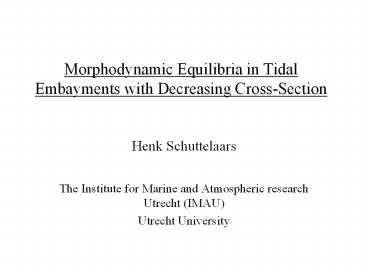Morphodynamic Equilibria in Tidal Embayments with Decreasing Cross-Section - PowerPoint PPT Presentation
Title:
Morphodynamic Equilibria in Tidal Embayments with Decreasing Cross-Section
Description:
The Institute for Marine and Atmospheric research Utrecht (IMAU) ... Noncohesive Material. Suspended Load Transport. Sediment Balance: hole. bar. Fine Sand ... – PowerPoint PPT presentation
Number of Views:22
Avg rating:3.0/5.0
Title: Morphodynamic Equilibria in Tidal Embayments with Decreasing Cross-Section
1
Morphodynamic Equilibria in Tidal Embayments with
Decreasing Cross-Section
- Henk Schuttelaars
- The Institute for Marine and Atmospheric research
Utrecht (IMAU) - Utrecht University
2
Contents
- Introduction
- Model Formulation
- Numerical Experiments
- Comparison with Observations
- Conclusions Future Research
3
Tidal Embayments
Introduction
- Semi-enclosed bodies of water
- Connected to the open sea
- Driven by tides
Examples
- Frisian Inlet System
- Western Scheldt
- Inlets East Coast of the US
4
Marine Part of the Western Scheldt
5
Amplitude Hor. Vel.
Phase Hor. Vel.
6
Salinity Distribution in the Western Scheldt
7
Properties
- Length 160 km
- Depth 20 m - 50 m - decreasing
- Complex Pattern of Channels and Shoals
- Main Channels 3-1
- Dredging
- Cyclic Behaviour
- Fractal Patterns
- Tidal Range Vl 3.2 m Ant 4.0 m
decreasing - M2/M4 0.1 (at entrance)
- Phase difference (approx. 1 tidal wave length)
8
Research Questions
?
- Do Long-Term Equilibria Exist
- Are They Unique and Stable
PARA- METERS
9
Research Questions
?
- Do Long-Term Equilibria Exist
- Are They Unique and Stable
- Can We Explain/Model/Predict
PARA- METERS
- Cyclic Bar behaviour
- Formation of Main Channels
- Splitting of Channels
- Formation of Thresholds
10
Model Formulation
- Idealized Models
Water Motion
Short Time Scale
Sediment Transport
Long Time Scale
Bed Evolution
Averaging
11
Model Equations and Assumptions
- Depth Averaged Shallow Water Equations
- Only Bed Erodible
- Noncohesive Material
- Suspended Load Transport
- Sediment Balance
Fine Sand
hole
bar
12
The Equations
Continuity
Momentum
Concentration
Bed Evolution
The Boundary Conditions
X0
XL
13
Sediment Flux
14
Geometry
Side View
W
W
Top View
E
Embayment
R
X0
XL
15
Parameter Continuation
Short Embayment
- Analytical Solution
- constantly sloping bed
- spatially uniform hor and vert
velocities - spatially uniform bed stress
For other parameters, continue this known solution
16
Parameter Continuation
Short Embayment
- Analytical Solution
- constantly sloping bed
- uniform hor and vert velocities
- spatially uniform bed stress
- net sediment import after channel reduction
For other parameters, continue this known solution
17
The Experiments
- Reducing WR
- Different Types of Equilibria
Experiment 1
- Comparison with data
Experiment 2
18
The Experiments
- Reducing WR
- Local Lorentz Linearization ( L 110 km ltlt
LMAX) - Different Types of Equilibria
Experiment 1
- Comparison with data
- Global Lorentz Linearization (L 100 km
LMAX)
Experiment 2
19
Maximum Embayment Length
Figure A1. The dimensionless frictional length
scale Lf Lg of the M2 tide versus the
dimensionless length of the em-bayment. Here Lg
is the frictionless tidal wavelength and Lf has
been computed using (A2) with 06. The water
depths Hf and Hmax are determined by the
characteristics of the morphodynamic equilibrium.
The intersection of these curves with the solid
curve determines the maximum embayment length
Lmax.
20
Width Variation
Bed Profile
WR/WE
Sea
Land
110 km
WR/WE 1
WR/WE 0.5
- Bed Very Deep
- Standing Wave
- M4extern amplified
- Bed Weakly Concave
- Travelling Wave
- M4extern negligible
Decreasing WR
21
Amplitude of M4extern Hor Vel
WR/WE
110 km
Sea
Land
22
Frictionally Dominated Equilibrium
23
External Equilibrium
Plate 2. Contour plots of the dominant
contributions to the net sediment flux (defined
in (11)) for the morphodynamic equilibrium that
owes its existence to the presence of external
overtides. Dependent variables are the
dimensionless coordinate x and the length scale
ratio LLg. Here Figure 2a shows us Cs , Figure
2b shows us Cs , Figure 2c shows u 2c C 2c ,
and Figure 2d shows u 2c C 2c . The scaling
for the fluxes is identical to that in Figure 5.
Here 015, other parameter values are as in
Table 3.
24
Comparison With Field Data (1)
Width
Width-Averaged Depth
25
Comparison With Field Data (2)
Sea
Land
Sea
Land
26
Conclusions
- Two Types of Equilibria
- Idealized Model Reproduces Global
Characteristics Quite Well - Multiple Equilibria
- Maximum Embayment Length
- externally driven
- friction-related
27
Future Research
- Closer Comparison With Process-Based Models
and Observations - Introduce Two Dimensional Perturbations
28
Multiple Equilibria

